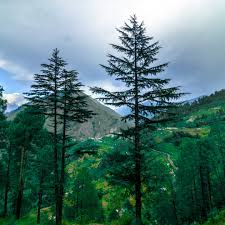Uttarakhand
Hundreds Turn Up To Save Trees In Uttarakhand
- 12 Mar 2024
- 5 min read
Why in News?
Recently, hundreds of men, women and children gathered at the holy Jageshwar Dham in Almora district of Uttarakhand to tie raksha sutra (thread for protection) around the region’s famous Himalayan cedar trees (Cedrus Deodara).
Key Points
- Some of the trees are over 500 years old and they surround one of the largest clusters of 125 temples within one complex in the world, situated at 1,870 metres above sea level.
- The raksha sutra was tied around more than 1,000 trees that were to be axed for a road widening project under the State government’s ‘Manas Khand Mandir Mala Mission’ that aims to improve connectivity to about 50 temples in Uttarakhand.
- It is similar to the famous Chipko movement of the 1970s to protect Uttarakhand’s forests from the increasing destruction due to rapid industrialisation.
- This is not the first time that the State government had drawn criticism for its allegedly reckless cutting of trees to aid development in Jageshwar.
- The Uttarakhand High Court in September 2018 had banned all construction activities around the temple site until the government framed building bylaws.
- The HC, taking suo motu cognisance of the “unplanned and unauthorised” construction around the Jageshwar temple complex, also ordered to stop the construction of the Aartola-Jageshwar road.
Cedar Trees
- Cedrus deodara, commonly known as the deodar cedar, is a species of coniferous tree native to the western Himalayas. It is highly valued for its timber and is widely cultivated for its ornamental beauty.
- These trees are adapted to cold climates and are often found at higher elevations.
- They are well-suited to temperate and subalpine climates.
- Deodar Cedars are often used in landscaping and as ornamental trees in parks and gardens due to their attractive, pyramid-shaped growth and aromatic wood.
- They provide habitat and food for various wildlife, including birds and small mammals.
Manaskhand Mandir Mala Mission
- Under the Manaskhand Mandir Mission the government will develop better roads along with better transportation facilities on the routes of the temples.
- Development of hotels and homestay facilities along the routes of the temples keeping in mind the volume of pilgrims visiting these mandir in the next 25 years.
- Under the first phase of the Manaskhand Mandir Mala Mission ,16 identified temples in the Kumaon division will be developed.
- Under the Manaskhand Temple Mala Mission following temples has been identified:
- Jageshwar Mahadev Temple in Almora
- Chitai Golu Temple
- Suryadev Temple Katarmal,
- Kasar Devi Temple
- Nanda Devi Temple
- Patal Bhuvaneshwar Temple in Pithoragarh
- Haat Kalika Temple
- Bagnath Temple in Bageshwar
- Baijnath Temple
- Patal Rudreshwar in Champawat
- Maa Purnagiri Temple
- Maa Barahi Devi Temple
- Baleshwar Temple
- Naina Devi Temple in Nainital
- Kainchi dham Temple and Chaiti Dham Temple in Udham Singh Nagar
Chipko Movement
- It was a non-violent agitation which originated in Uttar Pradesh’s Chamoli district (now Uttarakhand) in 1973.
- The name of the movement ‘chipko’ comes from the word ’embrace’, as the villagers hugged the trees and encircled them to prevent being hacked.
- It is best remembered for the collective mobilisation of women for the cause of preserving forests, which also brought about a change in attitude regarding their own status in society.
- Its biggest victory was making people aware of their rights to forests, and how grassroots activism can influence policy-making regarding ecology and shared natural resources.
- It led to a ban on commercial felling of trees above 30 degrees slope and above 1,000 msl (mean sea level) in 1981.







